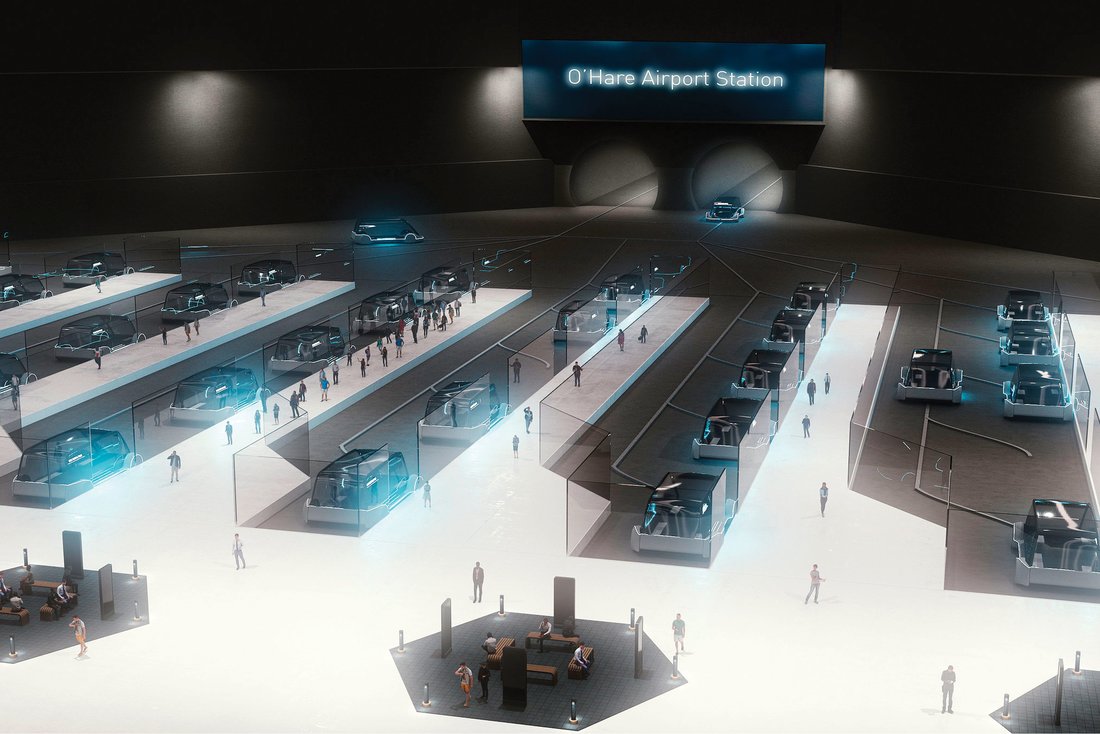马斯克最激动人心的公司名叫“无聊”
|
在洛杉矶西部温暖的沥青路、堵塞的交通和摇曳的棕榈树之下,埃隆·马斯克正在寻找答案。在那里,一架名为“戈多”(Godot)的机器可能很快就要在405号州际公路下面挖出一条2.7英里的隧道。这条公路可是让洛杉矶稳居全美最拥堵城市宝座的重要因素。 这条隧道目前正在等待施工许可,洛杉矶人可能还要等些时间才能看到它的完工(就像《等待戈多》里的弗拉季米尔和爱斯特拉冈一样)。但忙于在电动汽车厂商特斯拉(Tesla)和太空设备公司SpaceX担任首席执行官的马斯克需要证明一些事情。现实上看,他作为贝莱尔区(Bel Air)的居民,希望更方便地去往位于南部的霍索恩、距家17英里的SpaceX园区。而理论上看,马斯克希望证明地下的超音速公共交通不是未来主义的幻想,而是帮助那些美国最繁忙(资金也最紧缺)的大城市排忧解难的现实方案。 看看马斯克这家起名独特的“无聊公司”(Boring Company,Boring也有钻孔的意思——译注)。它宣布了连接巴尔的摩和华盛顿特区(相距35英里),以及芝加哥城区和奥黑尔国际机场(O’Hare International Airport)(相距17英里)的计划。芝城的Chicago Express Loop承诺单程用时仅需12分钟——这大大缩短了路上的时间,根据采用的交通工具不同,现在这一段路往往需要25到90分钟。这家Loop公司——不要把它与Hyperloop弄混,后者的速度更高、更有地区性——宣称他们的电磁运输仓可以搭载16名乘客,最高时速可以达到每小时150英里。按照计划,运输舱的发车间隔为30秒到2分钟,单向的运送量可以达到每小时近2,000人。 不过Boring Co.带来的不仅是技术。与其他类似规模的城市项目不同,这个芝加哥的项目不需要任何政府资金的支持:Boring Co.承诺完全依靠私募基金来承担这个很可能耗资数十亿美元的项目。由于芝加哥市开始征询提案,该计划得到了官员的完全首肯,这与处于法律边缘地带的洛杉矶和华盛顿特区项目完全不同。这让Chicago Express Loop成为了Boring Co.赢得的第一个巨大胜利,这也是公司迄今为止从城市政府那里获得的最强有力的许可,它可能成为公共基础设施未来发展的新方式。 |
UNDER THE WARM ASPHALT of West Los Angeles, beneath bumper-to-bumper traffic and swaying palm trees, Elon Musk is searching for answers. There, a boring machine named Godot may soon grind away at a 2.7-mile tunnel to run below Interstate 405, a key reason that L.A. retains its crown as the U.S. city with the worst traffic. The tunnel currently awaits a permit, and Angelenos may be waiting a while before it’s complete. (Paging Vladimir and Estragon.) But Musk, who spends his days juggling CEO roles at electric-auto maker Tesla and aerospace outfit SpaceX, has something to prove. Practically speaking, the Bel Air resident wants easier transit between his homes and the SpaceX campus in Hawthorne, 17 miles to the south. From a theoretical standpoint, Musk hopes to demonstrate that subterranean, supersonic public transit isn’t just a futuristic fantasy but a realistic solution for what ails many of America’s busiest (and most cash-strapped) metropolises. Enter Musk’s cleverly named Boring Company. It has announced projects to connect Baltimore with Washington, D.C. (a 35-mile span), and downtown Chicago with O’Hare International Airport (a 17-mile stretch). In Chitown, the Chicago Express Loop promises to ferry passengers from one end to the other in 12 minutes—far less time than the usual 25 to 90, depending on the mode of transportation. This Loop—not to be confused with Hyperloop, an ultrafast, regional version—boasts electromagnetic pods that each fit 16 passengers and can reach speeds of 150 miles per hour. It plans to transport nearly 2,000 people an hour in each direction, with cars departing every 30 seconds to two minutes. But it’s not just technology that the Boring Co. is bringing to the table. Unlike other urban projects of this size, no government funding is necessary to realize the Chicago project: The Boring Co. promises to privately fund the entirety of what will likely be a multibillion dollar effort. And thanks to a City of Chicago request for proposals, the plan has a complete go-ahead from officials—unlike the L.A. and D.C. projects, which face some time in legal limbo. That makes the Chicago Express Loop the Boring Co.’s first sizable victory and strongest validation from a city government to date, in what could be a path forward for future advancements in public infrastructure. |

|
德保罗大学(DePaul University)查迪克都市发展研究所(Chaddick Institute for Metropolitan Development)的主任乔·斯威特曼表示:“让我们面对现实吧,由联邦政府资助的城市铁路项目短期内不太可能回暖了。各城市需要自给自足,因此它们需要保持开放的心态,与私有企业携手合作,这点十分关键。” 美国的大城市长期面临着资本投资不足的状况。预计到2045年,每天穿梭于机场和市中心之间的旅客将达到3.5万人。芝加哥别无选择,只能借助私营企业——利用马斯克——来弥补运力缺口。不过The Transport Politic的城市规划专家约拿·弗里马克警告称,把公共项目交给私人也有风险。以芝加哥为例,居民对Boring Co.项目的技术和经济可行性就一无所知。 弗里马克表示:“公共部门允许公司推进这个项目,却没有真正考虑公众的想法。对于想要参与自身社区未来交通建设的人群来说,这一点值得担忧。” 另外,监管的障碍和政府的要求,例如环境分析和听证制度,又导致Boring Co.在加利福尼亚和马里兰的项目停滞不前。斯威特曼表示:“信号系统、利用这些工具运送人类所需的联邦许可、深度挖掘时所需的电梯和通风井——这些都是需要解决的重大问题。”(Boring Co.拒绝对此发表评论。) 不过马斯克仍然会勇往直前。如果他能在芝加哥获得成功,美国各地的官员可能都会愿意来一次类似的信仰之跃。毕竟,如果马斯克都可以发射火星探测器了,那搞定朋友之间的这一点基岩又有多难呢?(财富中文网) 本文的另一个版本登载于《财富》2018年8月1日刊,题为“埃隆·马斯克最激动人心的公司名叫‘无聊’”。 译者:严匡正 |
“Let’s face it—federal support for urban rail projects is not likely to bounce back anytime soon,” says Joe Schwieterman, director of DePaul University’s Chaddick Institute for Metropolitan Development. “Cities will be left to fend for themselves, making it critical that they remain open to private-sector collaboration.” Major U.S. cities face a chronic shortfall in capital investment dollars. With 35,000 daily passengers projected to move between the airport and downtown in 2045, Chicago is left with little choice but to leverage the private sector—and take a chance on Musk—to fill mobility gaps. But there are risks to placing public projects in private hands, warns Yonah Freemark, the urbanist behind The Transport Politic. In Chicago, for example, residents remain in the dark about the technical and economic feasibility of the Boring Co. project. “The public sector is allowing the company to move forward with this project without actual consideration from the public,” Freemark says. “That should be concerning for people who want to be involved in the transit future of their communities.” Elsewhere, regulatory hurdles and governmental requests—such as for environmental analysis and public hearings—have stifled the progress of Boring Co. projects in California and Maryland. “The signal systems, federal approvals required to put people on these vehicles, and the need for elevators and ventilation shafts when digging long distances beyond the surface—those are really big questions that are going to need answers,” Schwieterman says. (The Boring Co. declined to comment.) Still, Musk bores ahead. If he is successful in Chicago, elected officials across the country might be inclined to take a similar leap of faith. After all, if Musk can shoot for Mars, what’s a little bedrock between friends? A version of this article appears in the August 1, 2018 issue of Fortune with the headline “Elon Musk’s Most Exciting Company Is Boring.” |













